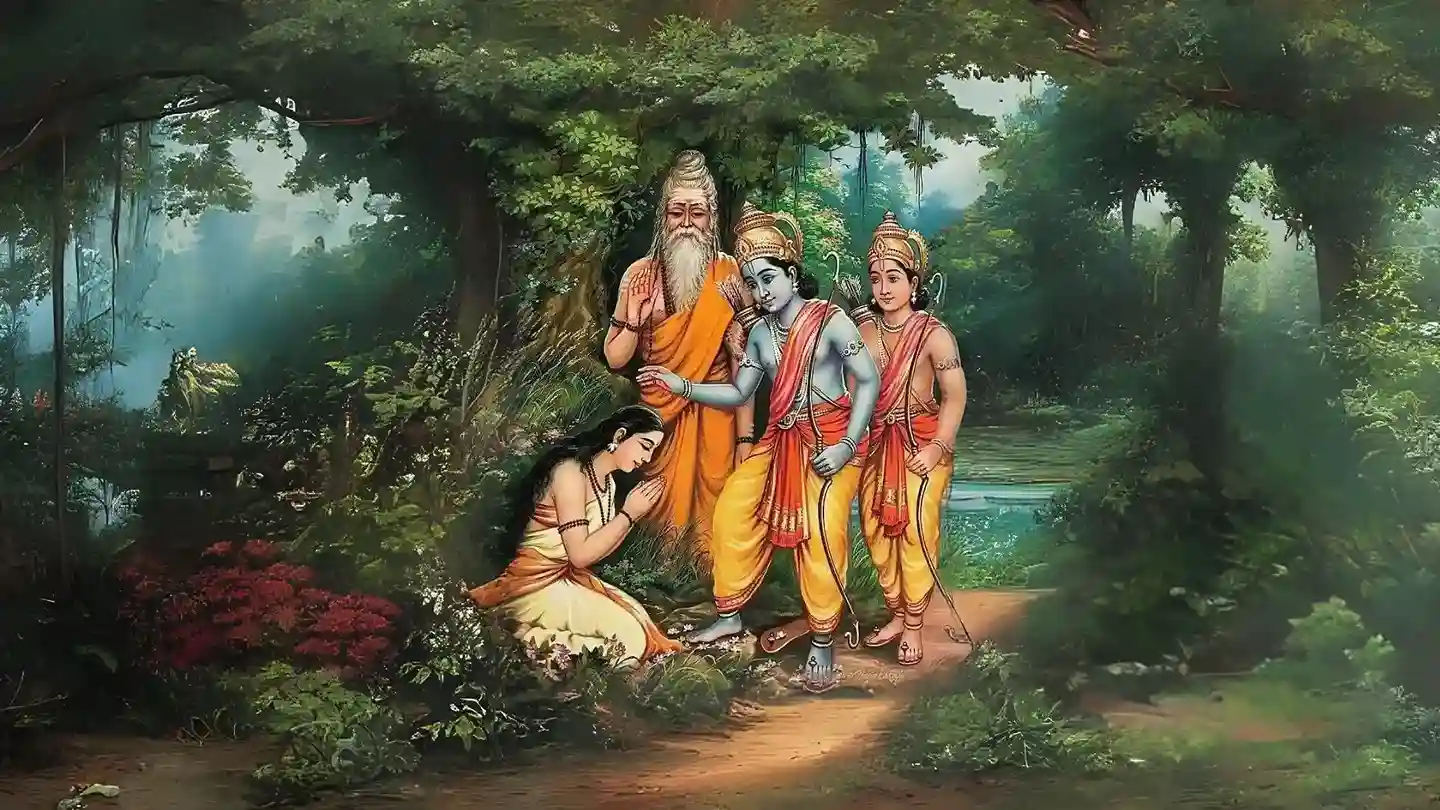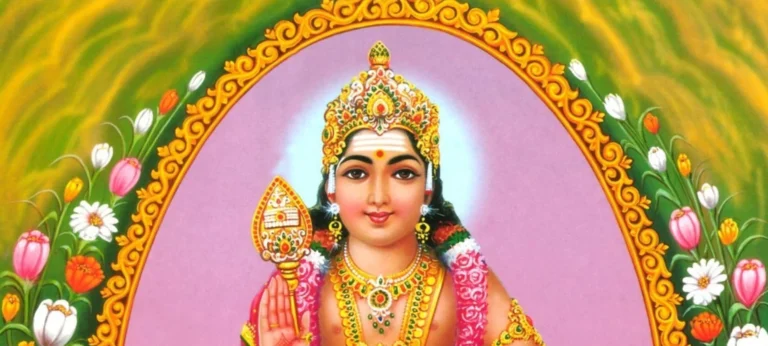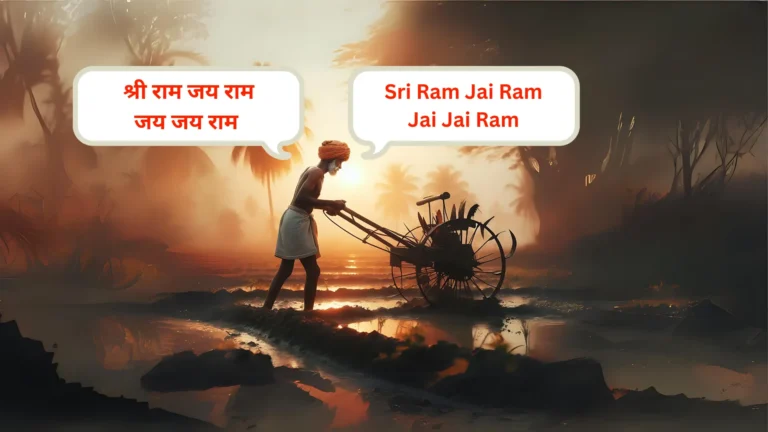Please Like the Blog and Share it for Maximum Reach
Table of Contents
Why meditate on the symbols of Sri Rama’s lotus feet?
The Bhagavad Gita says: Bhagavad Gita 8.6:
“yaṁ yaṁ vāpi smaran bhāvaṁ tyajaty ante kalevaram
taṁ tam evaiti kaunteya sadā tad-bhāva-bhāvitah”
यं यं वापि स्मरन्भावं त्यजत्यन्ते कलेवरम् |
तं तमेवैति कौन्तेय सदा तद्भावभावित: || 6||
Translation:
“Whatever object one remembers when he quits his body, O son of Kunti, that object he will attain without fail.”
Constantly remembering Lord Rama’s feet is the ultimate goal of Sadhana. Every symbol of Lord Rama’s divine feet can eradicate and cleanse sins of countless lifetimes. This method is like the powerful hydrochloric acid that can melt the dross of material life in one go.
Significance of Meditating on Sri Rama’s lotus feet

Symbols are easier to visualize and meditate when compared to the form of Bhagawan in the earlier stages of one’s sadhana journey. So this is an extremely powerful method in Bhakti Sadhana, for people who are serious in attaining Bhagawan, in this very lifetime.
Each symbol on Sri Rama’s lotus feet signifies a particular trait or thought pattern inside the human mind which needs to be immediately arrested during sadhana.
While doing sadhana it is natural for negative thought patterns to erupt in some situations. By the grace of Rama Nama, one may identify the vice as lust, greed, anger, envy, attachment, or pride.
One may even get conscious of it, but may not be able to correct oneself in daily life. Propelled by the Vrittis, the Sadhaka may behave sporadically and later feel guilty or repent for his actions. Now, how do the symbols of Sri Rama’s feet help such a sadhaka? Meditating on the symbol not only makes one aware of negative traits but also gives one the power to implement change.
The Sadhaka experiences a sense of fulfillment in sadhana, and can see true progress happen. Years of chanting may not prove as effective compared to contemplation of the sacred symbols of Sri Rama’s feet.
Science of Each symbol
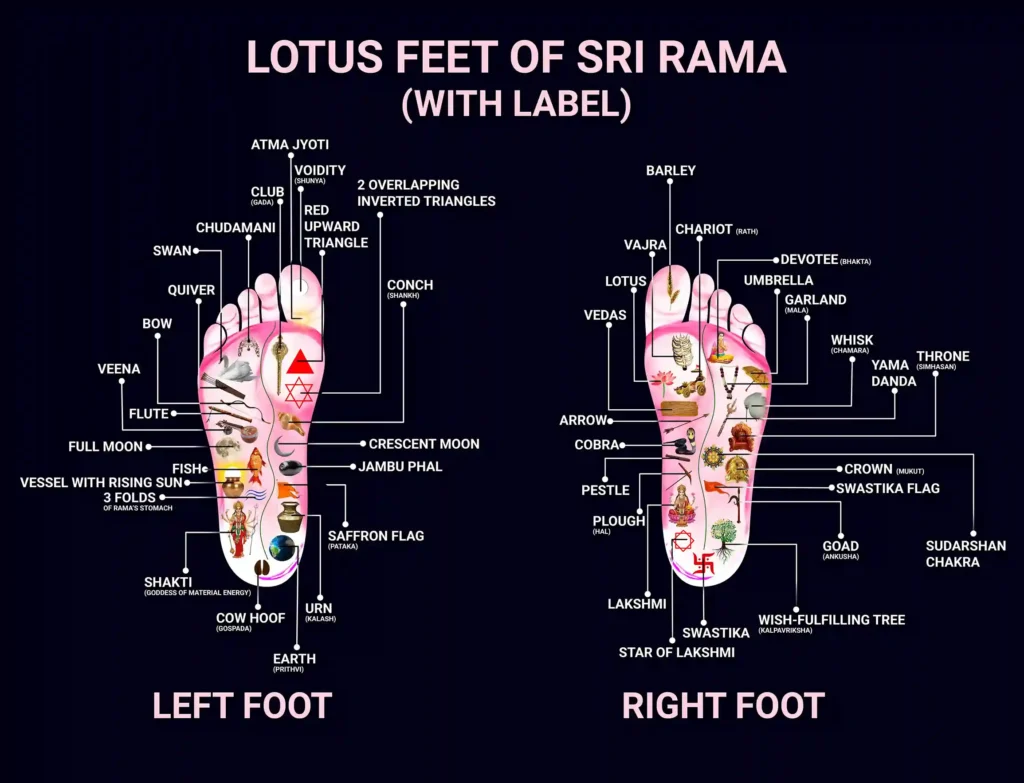
There are 24 symbols each in the two feet of Lord Rama. There are a total of 24 Vishnu Avatars and also there are 24 hours in a day.
Right Foot- 24 symbols
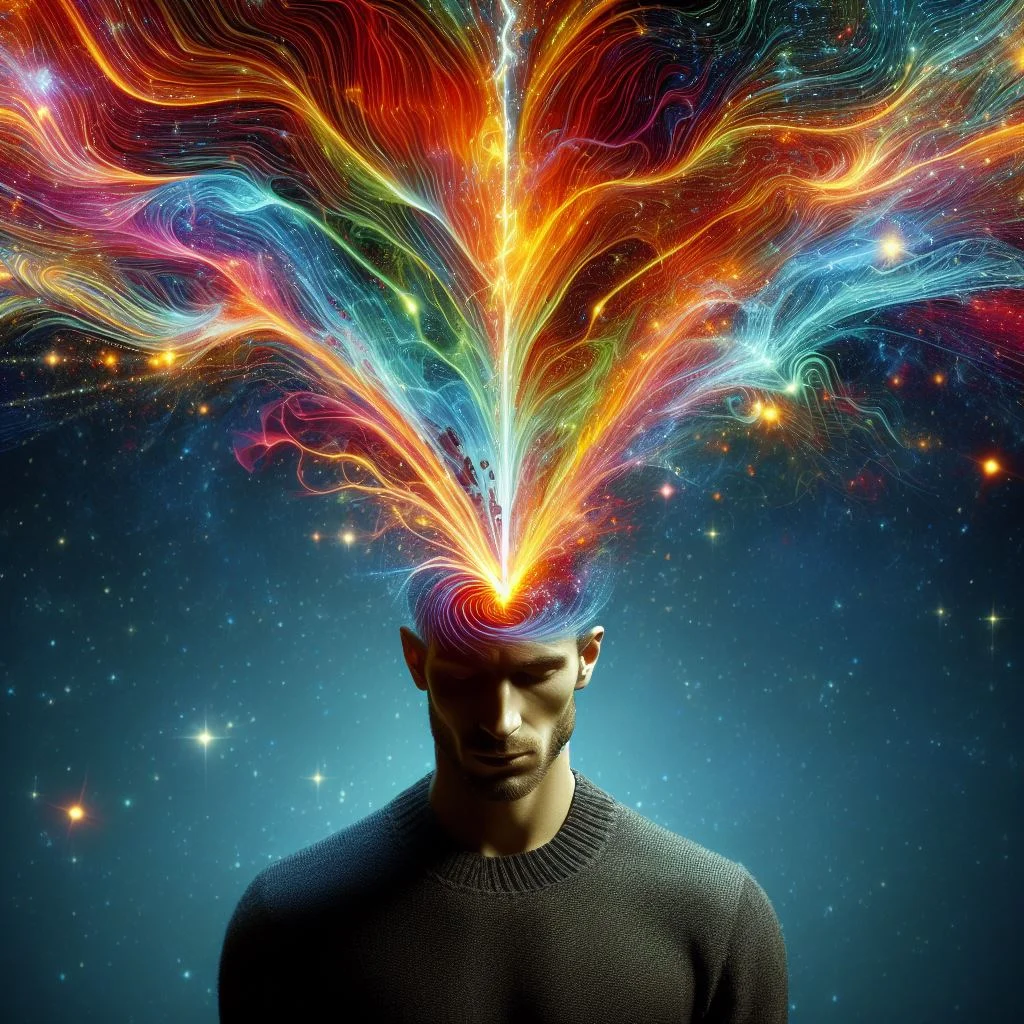
1) Swastika- Let us start from the bottom most symbol in Sri Rama ‘s right foot- The Swastika. Drawn at the entrance walls of homes during Griha Pravesh, Marriages or any auspicious occasion, Swastika has a great significance in Sanatana Dharma. Meditating on Swastika, attracts positive vibrations and can create an environment conducive for Sadhana. It brings both material and spiritual fortune.
2) The star of Lakshmi (Two Squares Overlapping at 45 degrees): This red symbol lies at the top-left side of the swastika sign. This octagram is a symbol of Ashtalakshmi, or the eight forms of wealth namely-
- Adi Lakshmi (The primordial goddess)
- Dhana Lakshmi (Goddess of Wealth)
- Dhanya Lakshmi (Goddess of Grains)
- Gaja Lakshmi (Goddess of Animal Wealth)
- Santana Lakshmi (Goddess of Offspring)
- Dhairya Lakshmi (Goddess of Patience)
- Vijaya Lakshmi (Goddess of Victory)
- Vidya Lakshmi.
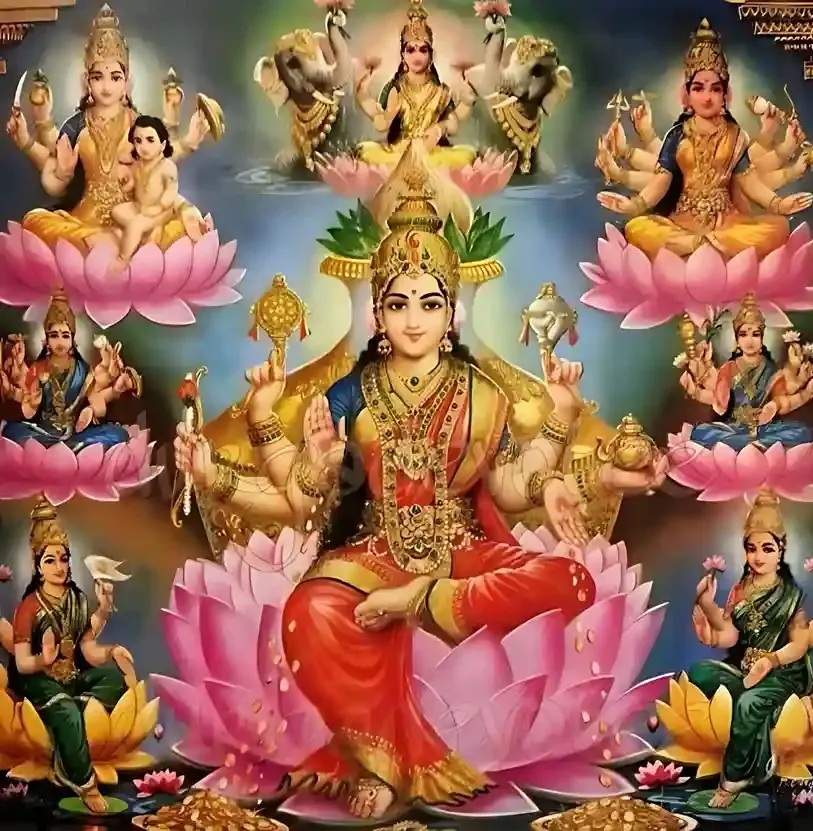
The two squares balancing and overlapping each other represent the ability to harmonize opposing natures. For example, we can see the harmony of anger and Patience in in Sri Rama’s character.
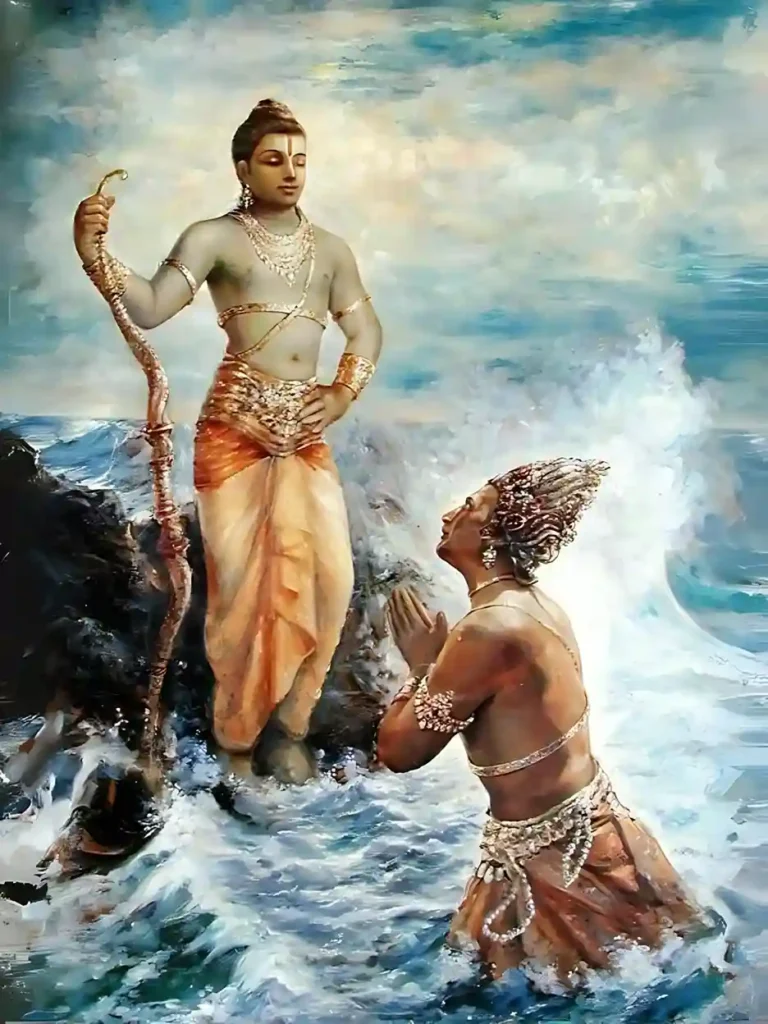
First he patiently waited for three days and on seeing the sea god’s indifference he displayed his extreme anger. Sagara trembled with fear to see the anger of the otherwise peaceful Lord. Thus we can see the harmony of two contrasting natures in Sri Rama’s wonderful personality.
In mortals, this aspect is missing. Some people present their cowardice as patience while others are extremely impulsive and react at the drop of a pin. However, by meditating on this geometric structure, one develops decision making capabilities, knowing when and how to react in certain situations. It also brings a balance in material and spiritual life.
3) Wish Fulfilling Tree (Kalpa-Vriksha): Whoever meditates on the Kalpavriksha has all his desires fulfilled, without one’s asking. However, the Lord first reviews and checks whether the desires are valid and conducive for spiritual life.
Only then he fulfills them. This Bushy abundant tree also symbolizes growth and flourishment. If one continually meditates on the Kalpavriksha Symbol, Lord Rama removes unwanted yearnings and replaces them with spiritual desires, which fuel the path of Bhakti.
4) Elephant Goad (Ankush): Ankush literally means ‘to put an end to’. The Symbol lies above the Wish Fulfilling Tree. The Ankush symbol has special relevance in a Sadhaka’s life, from time-immemorial. Ankush or a goad is a tool using which a Mahaut (elephant caretaker) controls his elephant. In the Vedic Pantheon, an elephant represents the sexual urges of a human being.
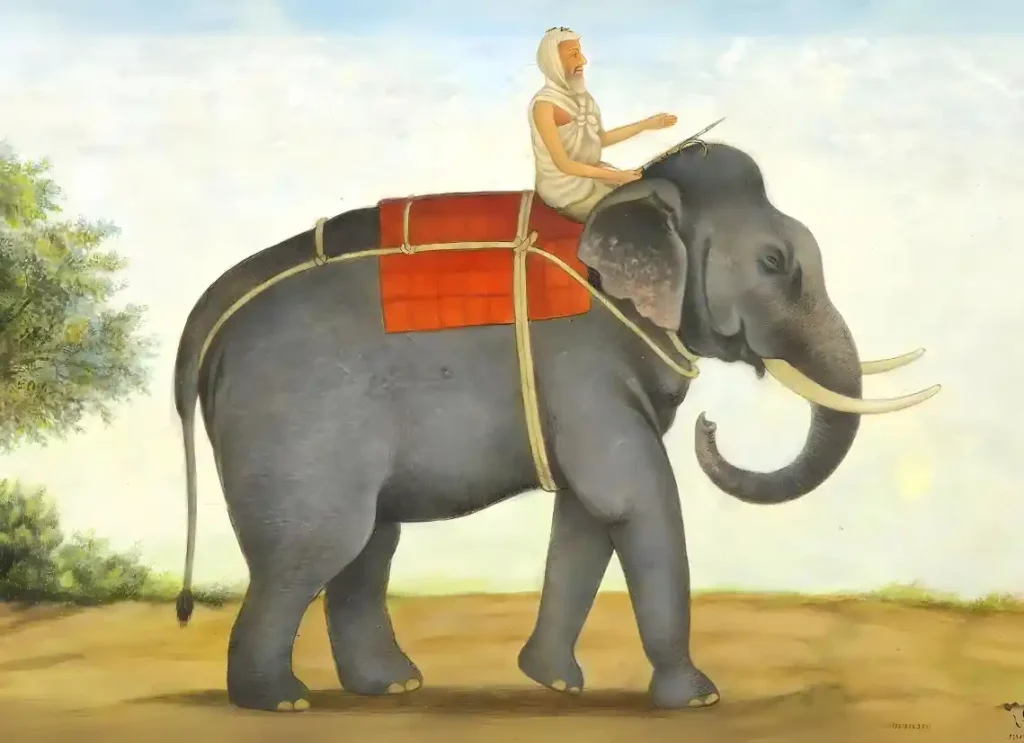
Why an elephant specifically? This is because earlier hunters would lay a trap by digging a pit and letting loose a female elephant to entice a wild male elephant. Stuck by the arrows of cupid, the male elephant would follow the she-elephant and willingly walk towards his own grave, falling into the pit.
In modern context, many Sadhakas face difficulty in controlling their lustful thoughts and feel guilty at the end of the day. Here, the Ankush symbol serves a spiritual medicine to the problem of lust. When a man meditates on the Ankush symbol, his lustful urges and night-falls are arrested over a substantial period of practice, which is otherwise impossible to control even at old age. He becomes celibate by thought, word and deed. This is a proven fact.
5) Goddess Lakshmi: We see a picture of Lakshmi Devi above the two overlapping squares on Sri Rama;s right foot. As we all know, she represents wealth and prosperity. By meditating on her symbol, the sadhaka attracts money from good and pious sources, suitable for Dharmic activities.
Note that she has a deeper significance for devotees of the Lord. She is Sitaji, the Dharma Pati, most obedient wife of Sri Rama, who always resides at His lotus feet. Hence, Sadhakas should meditate on her symbol not just for wealth, but also for inner purity and devotion that can attract Sri Rama towards us.
6) Swastika Flag: Right above the goad lies the image of a Swastika flag. Since vedic times, the swastika flag has been a symbol of Dharma, righteousness. Lord Rama is Maryada Purushottam, a great follower of Dharma.
Hence, meditating on the flag, instills the qualities of righteousness, higher ideals and moral principles in the sadhaka, which attracts the attention of Sri Rama.The Sadhaka becomes committed to his duties and executes his responsibilities with perfection as result of meditating on the flag symbol.
7) Plough: The plough symbol lies just above the image of Sri Lakshmi Devi. The Plough is a part of Sri Balarama, who is Guru Tattva, the spiritual mentor and inner guide. Thus, it represents Sri Lakshmana who always resides at the lotus feet of Sri Ramachandra.
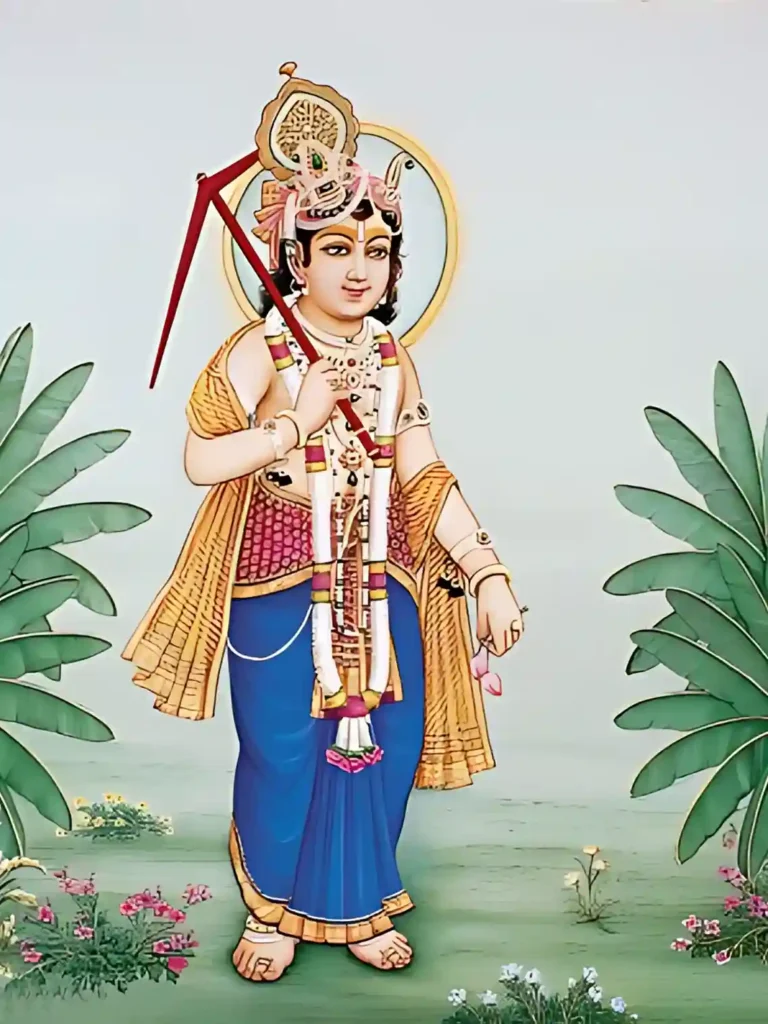
The Plough symbolizes hard work, perseverance and the efforts one puts in towards the goal of Sadhana. It also indirectly represents Sita ji, as she appeared from the ploughing of fields.
Farmers use a plough to till the soil and crumble hard stones, facilitating the growth of crops. Hence, meditating on the plough symbol dissolves all the stones of hard feelings, opinions and distortions and makes the soil of our heart fertile for the seed of Bhakti to grow.
8) The Golden Crown: Right above the Swastika flag lies the Golden Crown. A Crown is placed at the head which is the seat of Knowledge and intelligence. So, meditating on this symbol dissolves corrupt thinking patterns and instills noble thoughts in the mind.
One develops a keen sense of judgement and makes sound decisions that shall benefit one and the family at large. It helps curb greed, ambition and attraction towards gold and money.
9) Pestle: In rural homes, a Pestle is used to pound spices and render flavor to the food. This symbol lies just above the Plough at the left partition of Sri Rama’s feet. In a sadhaks’s context, meditating on the Pestle symbol pounds all of our Problems and heavy Karma, ultimately giving us the juice of Bhakti.
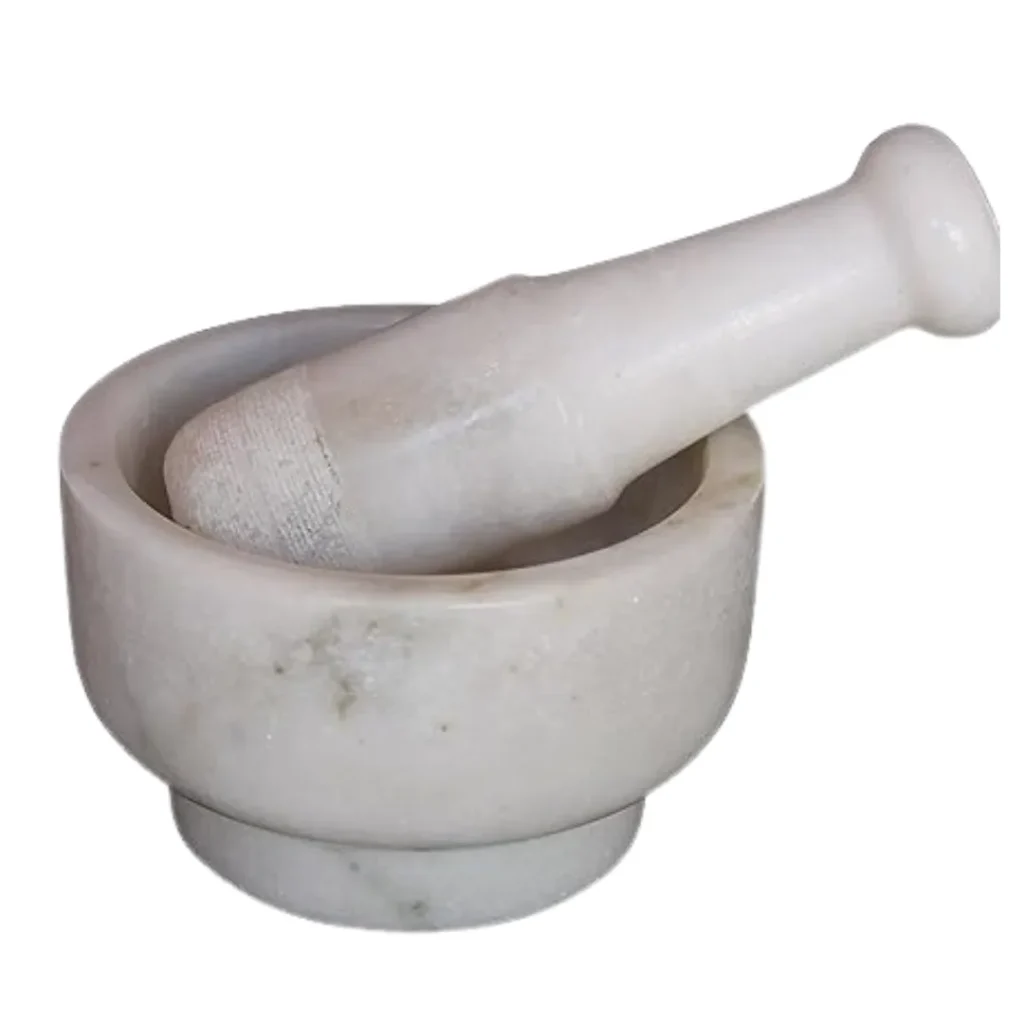
It is through this Pestle that Maya pounds the living entity to undergo the sufferings of life. Hence, the pestle symbol meditation can help reduce the burden of bad Karma and finally extract the ultimate truth through Sadhana.
10) Sudarshana Chakra: Sudarshana Chakra lies just above the Crown Symbol. Just as it cuts the heads of demons with its sharp spokes, meditating on the symbol cuts our Karmic load and the vices of Lust, Anger, Pride, Greed, Attachment and Envy. As a result the Karma of say 10 years may appear in one single year, fast-forwarding the Karmic cycle.
At such times one must hold the hand of one’s Guru and sail through the turbulent waters of Maya. Also, Sri Bharata is the incarnation of the Sudarshana Chakra and he has a place reserved at the lotus feet of the Lord in the form of this symbol.
11) Black Cobra: Right above the pestle is the image of a Cobra. The cobra on the right foot of Sri Rama’s lotus feet signifies the vicious tendencies of taking revenge and being ungrateful.
Meditating on this particular symbol can have a calming effect on the personality, enabling one to forgive and forget, not psychologically, but in the practical sense. Thus we easily cross a great milestone that could have posed a hindrance in one’s Bhakti towards Bhagawan.
The cobra is also closely connected to Lord Balarama and Shivji as Sheshnaag and Vasuki respectively. Not only does meditation on this symbol remove the poison from our minds but it also keeps demonical people away from us. Snakes also represent the reptilian tendency of being clingy, untrustworthy and opportunistic.
Hence, Meditating on the Cobra symbol works on these aspects of our character. The Symbol on the Lord’s feet actually represents the antidote to poison, for that fact that it is on the Lord’s feet.
12) Arrow: The arrow symbol is present just above the cobra. It works on our mental faculties of being able to concentrate and focus, streamlining our thoughts. The ability to meditate for long hours comes when one focuses on the arrow symbol for a protracted period. Furthermore, one is able to fix one’s spiritual goal and remove unnecessary distractions to achieve it.

13) Throne: Above the Sudarshana Chakra lies a royal throne. The throne works on the vice of pride. It also signifies a sense of discrimination between right and wrong/good and bad. Meditating on this symbol strengthens one’s principles and ethical values. The throne also represents Lord Rama sitting in the heart of every living entity.
14) Vedas: The vedas are positioned above the arrow in Lord Rama’s right foot. Vedas signify knowledge, wisdom and deep realizations that sprout from intense sadhana.
15) Yama Danda: The Yama Danda is a fatal weapon using which Yamaraj punishes sinners in hell. For a sadhaka, contemplation of this symbol erases traces of sins whose impressions carry on life afterlife. It is a symbol of power and justice absolutely brutal with sinners and demonic beings.
Meditation on the Yamadanda gives the Sadhaka the grit to remove sinful and undesirable associations from his life, feeling no remorse for having done so. Thus the symbol gives strength and confidence in the devotional path. It also gives the meditator, a sense of Truth and alignment to the Self and transforms him into a righteous being, following Dharma.
16) Chariot: The symbol of a chariot lies above the Vedas. The Chariot signifies the swift and fast pacing mind. By meditating on the symbol the Sadhaka can control the reins of his mind and direct it towards the feet of the Lord. One can also consider the chariot, the means to reach the spiritual domain of Lord Rama.
17) Chamara Whisk: Meditation on the Chamara inculcates the mood of seva or service, as we imagine fanning the lord. The goal of life is to serve Bhagawan. Seva is the finality of Bhakti or Devotion. The correct mood of Seva is achieved by contemplating on the Chamara symbol. Also the Chamara represents the wind element and Vata (Ayurvedic term for air element) in the body.
18) Lotus Flower: In contrast to the Yamaganda, the lotus flower gives the flavor of soft emotions, bringing a balance in one’s overall personality. It helps curb anger and temper issues. Along with masculine emotions of dedication, and persistence, one must also have a balance of feminine emotions of love, sensitivity and devotion. Both Lakshmi-Narayana hold a lotus flower in their hands.
So it is a wonderful means of remembering our eternal parents. A sadhaka should contemplate on the lives, character and principles of great devotees like Sri Bhishma, Kunti Devi, Lord Bharatha, Sri Lakshmana, Sri Hanumanji Maharaj, etc. A sadhaka should strive to follow in their footsteps.
19) Umbrella: Just like how an umbrella protects us against rain and sunlight, this symbol on Sri Rama’s feet, protects the jeeva from the heavy onslaught of karma. If a sadhaka is facing turbulence in life, contemplating on this symbol with faith and reverence shall abate the intensity of Karma. It shall manifest Karma such that the sadhaka does not feel overburdened by it.
20) Garland: This symbol is an excellent means to serve the Lord. Contemplate on Sri Rama. After stringing flowers together, offer the garland to Hanumanji. Sri Hanumanji shall personally offer the handmade garland to Sri Rama. Everytime you contemplate this symbol, try improving your garland for the seva. You can envision flowers that are unearthly, probably having multicolored petals.
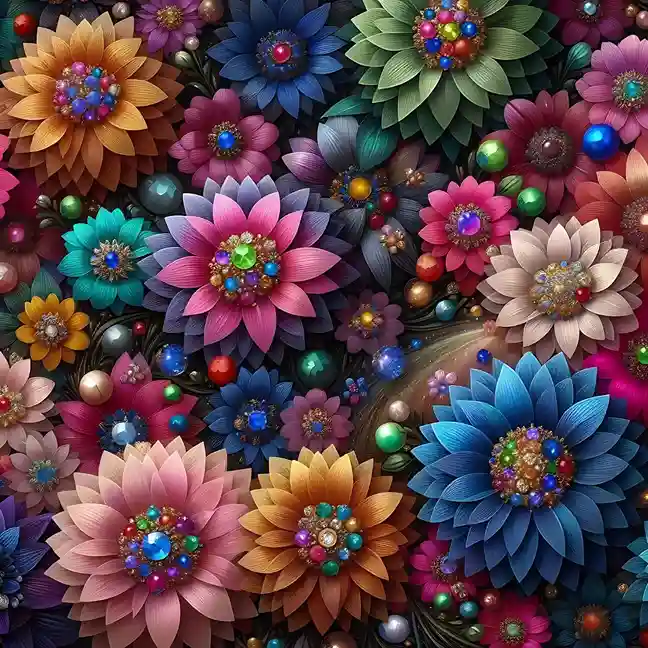
Some flowers may have studded gems on them, while certain others may be as soft as butter with exquisite colors. If you are experiencing an influx of negative thoughts and emotions, give them a form of a flower. String them together and hand it over to Sri Hanumanji who is an embodiment of the Guru Tattva. He shall heartily accept it and bring it into Sri Rama’s service. This is the most potent way of cleansing the mind.
21) Devotee (Bhakta): Consider oneself lower than a blade of grass and contemplate on the symbol of a Bhakta. With folded palms communicate with Bhagawan. Just like how we express ourselves to our near and dear ones, a sadhaka should take the golden opportunity of strenghtening his relationship with Bhagawan.
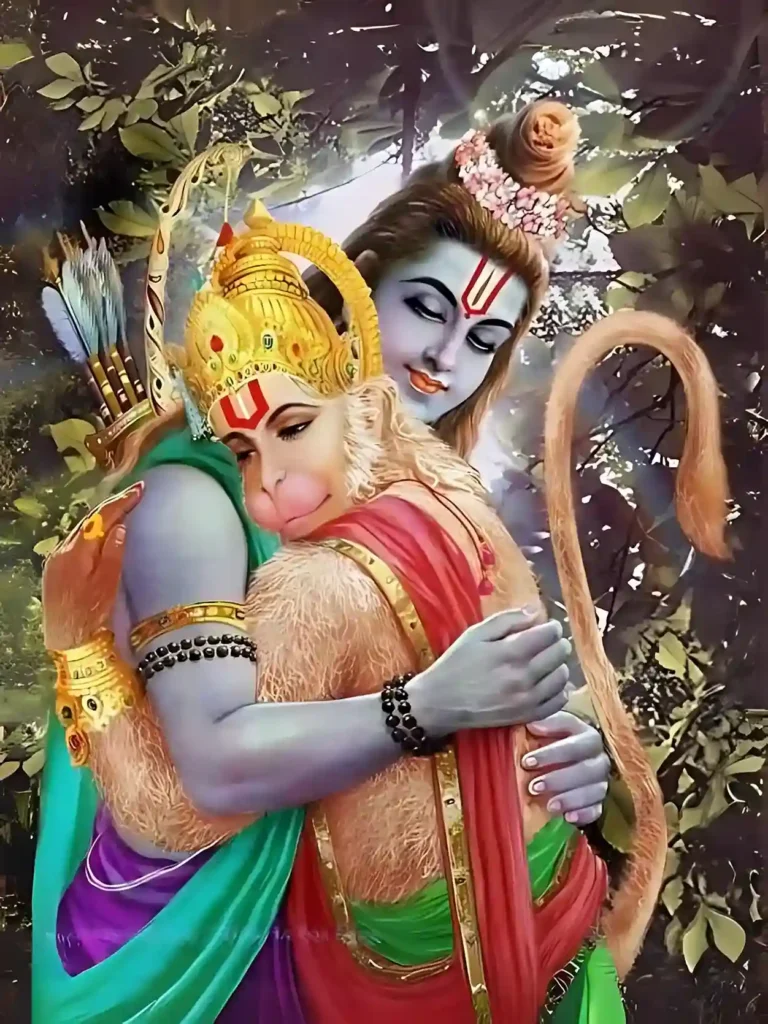
Now, make Bhagawan your dearest. Share your inner fears, insecurities, joys and sorrows. While concluding your meditation on this symbol, make a humble prayer that you should attain pure devotion. Whatever, the case may be, pray to the Lord that you should never forget Him.
22) Vajra: It is a symbol of power. The Sadhaka who meditates on this symbol regularly develops an unmovable determination to follow his/her spiritual discipline. This weapon has also had a history of defeating many demons who are evolutes of Rajas and Tamas. Thus, Rajasik and Tamasik people are also subdued by a sadhaka who meditates on this symbol over a prolonged period of time.
23) Barley: Barley is rich in antioxidants, minerals, vitamins and fibers. It has detoxifying properties. The presence of Barley crop tells us that Sri Rama’s lotus feet provides spiritual nourishment and removes the toxic Vrittis and impulses from our mind.
24) Reed: It is a long wavy line partitioning the Lord’s feet. This symbol exists in both the feet of Lord Rama, dividing each foot into two sections. Reeds are tall grasses that provide food and shelter for numerous organisms.
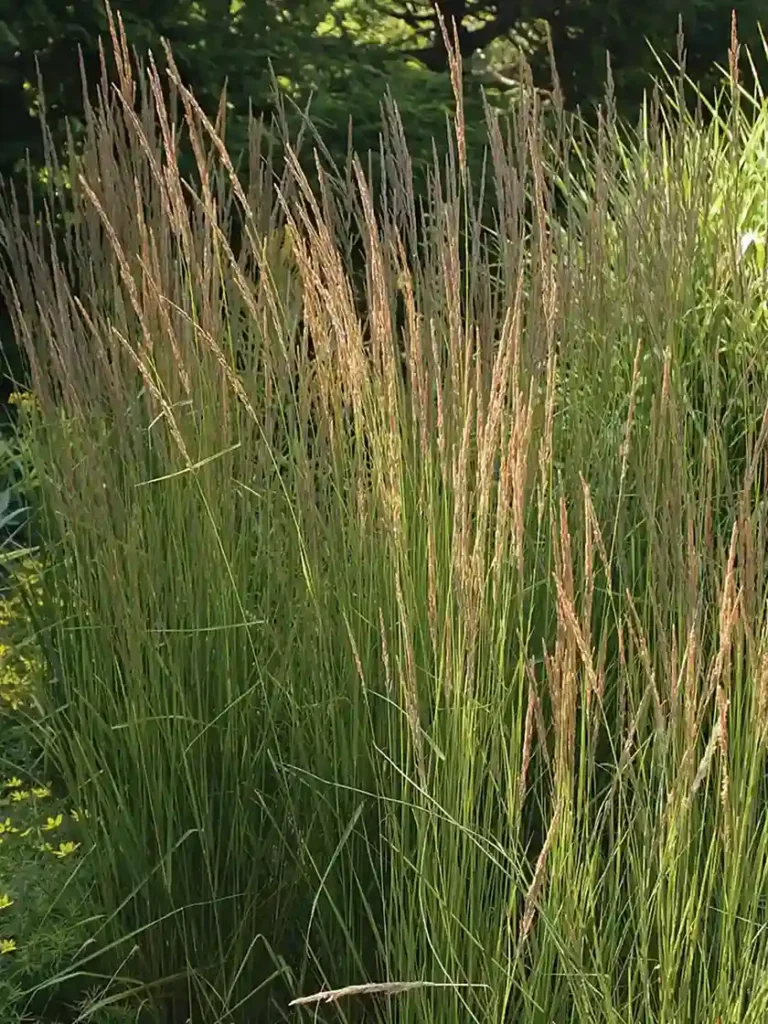
Well, it highlights a particular trait in Sri Rama’s personality and that is of sustenance. As Mahavishnu, he provides for the living entities and looks after them like a doting father. So, by meditating on this symbol, we urge Lord Rama to maintain us and take our complete responsibility.
This symbol can help one cultivate the mood of Sharanagati or complete surrender where one is no longer worried about one’s basic survival needs. Reed also refers to the Shloka of the famous Avatara of Sri Rama in the context of Sriman Chaitanya Mahaprabhu (known primarily as the combined incarnation of Sri Sri Radha Krishna), mentioned below in the section “Right Mood of Sadhana“.
7/8 Questions from Sanatana Dharma
The scores generated in this Quiz may or may not be absolute. There may be right or wrong answers to each Question. A percentage towards 100 indicates that you are more aligned to the overall subject matter.
Left Foot- 24 Symbols
1) The cow hoof (gospada): The hooves support the entire body weight of the cow. The gospada, situated in the extreme bottom of Sri Rama’s feet signifies the weight of the mind. While meditating on the gospada, the sadhaka must use the tool of awareness to scan the mind and see what type of thoughts and emotions are occupying the mind?
By continuous meditation on this wondrous symbol, awareness dawns, diminishing the weight of negative thoughts. This mighty material world shall become insignificant and small just as the distance it takes to step over a cow hoof.
2) The Earth (Prithvi): Earth is one of the 5 elements. It is a major constituent of the human body and is responsible for grounding. When it is in an imbalance, we feel disinclination towards Life. Meditating on this symbol, rejuvenates the mind and encourages it to tread the path of sadhana, as sadhana alone can yield ultimate satisfaction. This symbol strikes a balance between the mind, body and soul.
3) Goddess of Material Energy (Shakti): Shakti means raw energy. She is the mobile energy that is responsible for the manifestation of events in life. She also governs our emotions and interest towards the World. When a sadhaka meditates on Devi, who finds place in the Lotus feet of Lord Rama, he/she invokes Her grace to progress in the Bhakti Marga.
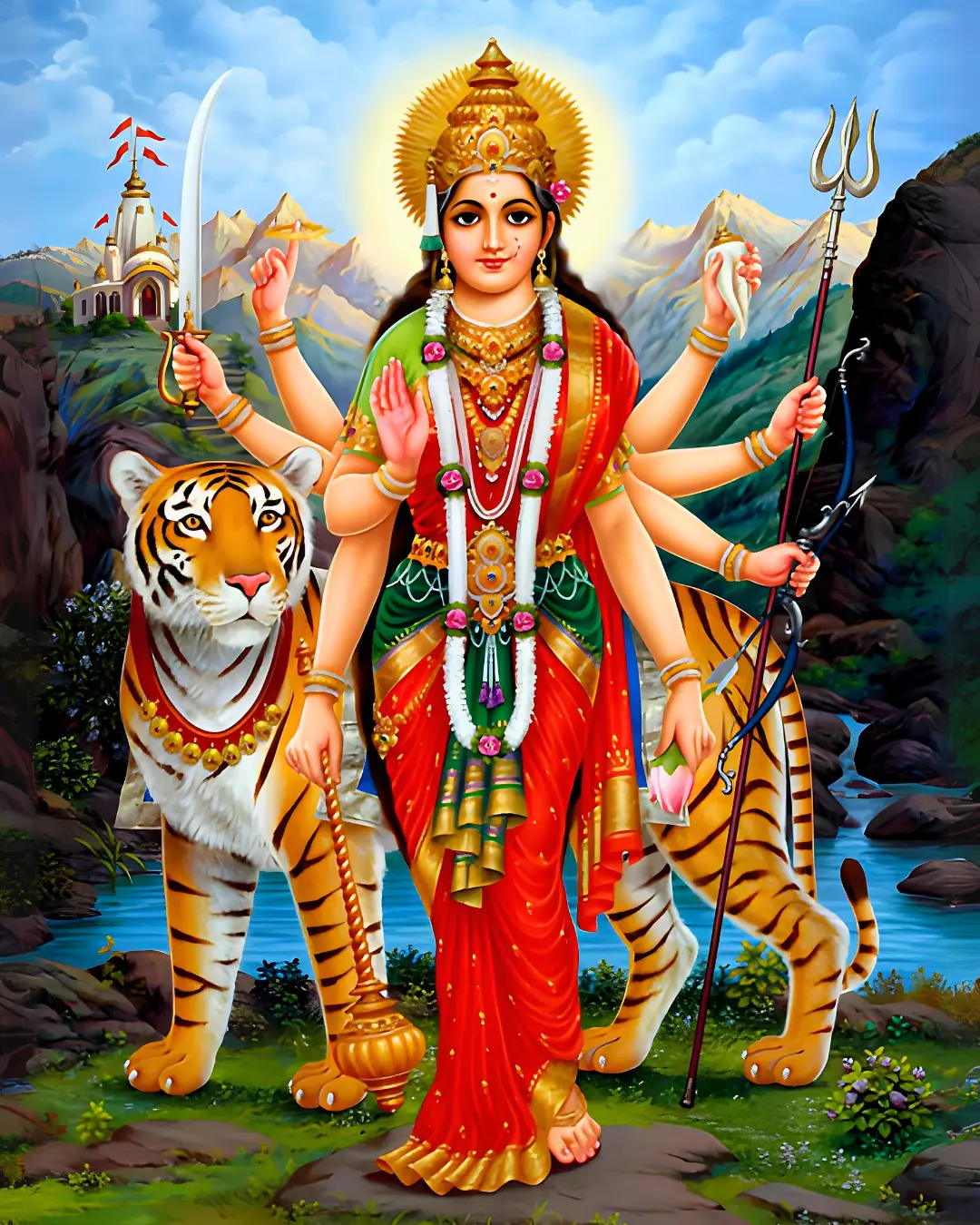
Though Devi torments individuals pursuing material goals, she shall exclusively manifest in the form of an encouraging mother who cherishes the sadhaka for treading on the Bhakti Marga. Continuous meditation on Devi, shall weaken grasp of material life, unconducive events and emotions. The Sadhaka experiences heightened states of consciousness as Devi suctions the dross of Maya.
4) Urn (Kalash ): The urn on the feet of Sri Rama contains ambrosia. The ambrosia relates to Bhakti Bhava while the urn signifies a purified heart. The urn prevents our Bhakti from getting public attention.
Thus, meditating on this symbol preserves our Bhakti exclusively for the Lord. A true sadhaka never displays his emotions outwardly. To the world, it may appear as if our heart is filled with poison. But, only Sri Rama shall savor the sweet mellows of Bhakti. This is the greatest benediction for the Sadhaka.
5) 3 Beautiful folds of the Lord’s stomach: According to the Shastras, upon dissolution, the entire creation suspends in the abdomen of the Lord. The water element in the abdomen of Sri Garbhodakasayi Vishnu swallows the entire Creation.
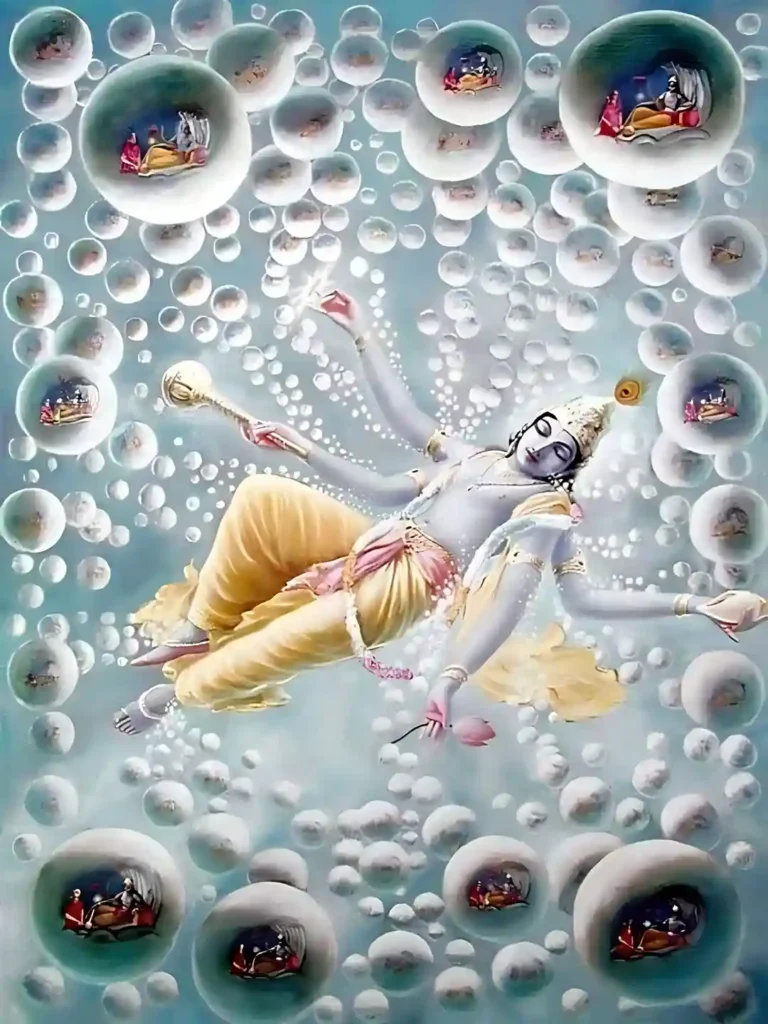
Thus, the water element stores all past impressions of cosmic creation as well as an individual’s personal experiences. It houses our memory cells across various lifetimes. By meditating on the 3 folds of the Lord’s abdomen, the 3 modes of material nature namely- Sattva, Rajas and Tamas get subdued.
These attributes trigger our past impressions and also cause newer impressions to pile up. Constantly meditating on this holy symbol traces us back to our origin. In this state, there remains no past residue. The mind ascends to the Shuddha Sattva platform, which is beyond the reach of Maya.
6) Saffron Flag (Pataka): Flag symbolizes victory. In history, great rulers like Chatrapati Shivaji Maharaj established the saffron coloured flag to show the supremacy of Sanatana Dharma. By meditating on this symbol a sadhaka gradually attains victory over the frailties of the mind.
The saffron color symbolizes Sanatana Dharma. The toxicity and oscillating nature of the mind can only be subdued by making ‘Dharma’ its anchor. A sadhaka must, with all faith, follow the Vedic injunctions as extracted by a bonafide Guru. This symbol empowers the Sadhaka to stay firm on the path of Dharma, without which attaining Bhagawan is a far-fetched dream.
7) Vessel with a rising sun: The sun represents the soul while the vessel the heart. It symbolizes the influence of the soul on the heart. The more one meditates on the symbol, the purer one becomes in thought, word and deed.
The soul which was buried deep in the debris of the mind, now gets exposed through the power of Sadhana and repeated meditation on the symbol. Then, the soul takes over the mind and becomes the initiator of all action (Karma).
8) The Upward Fish: Fish are great swimmers. A sadhaka must strive to be as agile as a fish and have the fervor desire to cross over the ocean of material existence. It is situated above the ‘3 folds of the abdomen’ symbol. Thus, it immediately pulls us out of the 3 modes of material nature. Just like how a fish cannot live without water, a sadhaka meditating on this symbol cannot stay without remembering the Lord. Thus, this symbol purifies the mind by flooding it with the pastimes, names and glories of Bhagawan.
9) Roseapple (Jambuphal): This symbol represents Jambudvipa or the holy land of Bharat. ‘Jambudvipa’ finds mention in many sacred texts and is hailed as a punya Bhumi. Individuals residing in Bharatha Bhumi can accumulate a lot of good karma.
Sadhaka make dramatic progress by performing sadhana in this holy land for it is the birthland of Lord Mahavishnu’s several incarnations like Sri Rama, Sri Krishna, Sriman Chaitanya Mahaprabhu, etc.
This land is conducive for sadhana as pure sattvik food is available to everyone. With very little effort, sadhaka can follow Yamas and Niyamas which may not be possible in foreign lands. These rules are mandatory for the fruition of any sadhana. Thus, meditating on this symbol restores purity and acts like a catalyst for spiritual progress.
10) Crescent Moon: Crescent Moon is exclusively adorned by Lord Shiva. While meditating on this symbol, the Sadhaka attracts the grace of both the divinities Lord Shiva and Lord Rama. The waning and waxing phases of the moon reflect the fleeting pains and pleasures of life. It indicates impermanence.
Thus, Jnana dawns on the sadhaka who constantly meditates on this symbol as a blessing of Lord Shiva who is the Guru Tattva. A sadhaka shall never be in dichotomy, as His sublime spiritual wisdom (Viveka) shall guide him.
11) Full Moon: The full moon lies above the Kalash symbol. It represents the human mind and the various mental states one experiences. Also, as per our Puranas, Amrit, or nectar is present in the moon. Hence, Meditating on the full moon symbol makes our mind and mood conducive for spiritual activities enabling one to taste the nectar of Bhakti.
12) Conch: This symbol is commonly present in the feet of Lord Krishna, Srimati Radharani and Chaitanya Mahaprabhu. The conch is a powerful paraphernalia blown at the start and end of Arati. It drives away inauspicious and negative energies, clearing the auric field for higher pursuits.
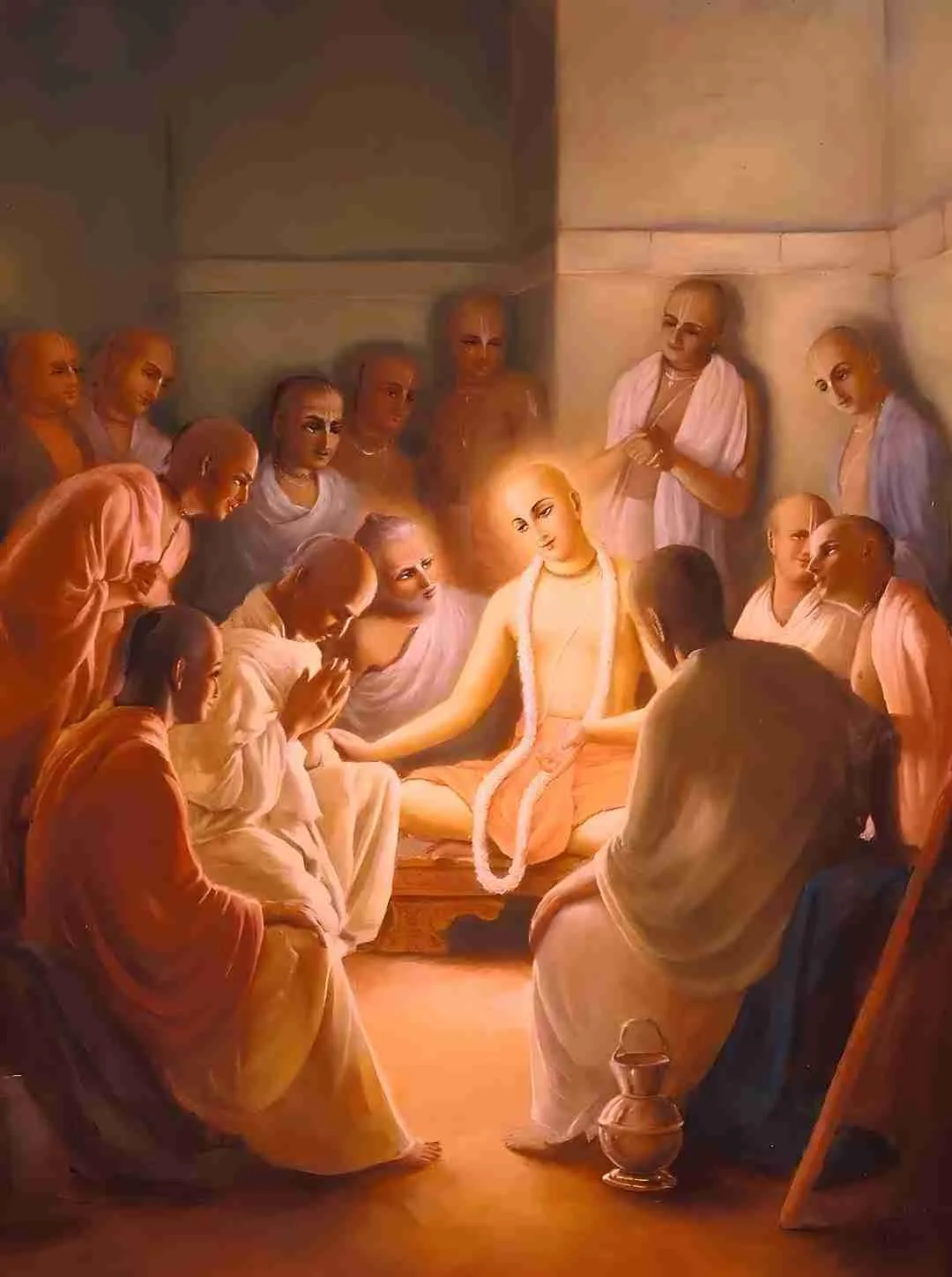
In the life of a spiritual aspirant, the mark is a symbol of terror for the latent negative thought patterns and vrittis that cause inertia. Hence, meditating on the Conch symbol ensures victory in Sadhana.
13) Veena: Veena is the musical instrument of Saraswati Devi, the goddess of creativity and wisdom. Meditating on the veena symbol generates creative ideas and interest to perform work.
One comes up with newer and innovative ways to execute one’s duties. Boredom shall disappear and the zest to live life heightens. The person becomes inclined to participate in hobbies and pastimes. By meditating on the veena symbol, consciousness flowers and blossoms.
14) Two Inverted Triangles overlapping each other: There are two inverted triangles in this geometric structure which overlap each other. The Upward Pointing triangle depicts the case of a spiritual practitioner while the lower triangle portrays a typical materialistic man.
In the case of a spiritual person, the energy rises from lower energy centers to higher planes depicting the pointed vertex. However, material man expends his energies in sense enjoyment leading to dispersion of life force. As a result, dilemma, confusion, nervousness and fear grapple the mind because the Shakti travels downwards to the Muladhara, the base Chakra.
Material consciousness is more active for such a person. Higher objectives take a backseat and one begins to procrastinate. However, focussing on this geometric structure prevents unnecessary dispersion of energy bringing a balance.
To move from this balanced state to a higher state, focus on the symbol discussed next.
15) Red Upward Triangle: Red is the colour of the Muladhara Chakra. As the triangle is pointing upward, it denotes upward energy flow, from the Muladhar to Sahasrara chakra. Hence, meditating on this red upward triangle enables the ascension of energy.
16) Flute: Right above the veena, is the picture of a flute. The Flute is an inseparable part of Sri Krishna, who is non-different from Lord Rama. Lord Krishna’s flute would enchant the cows and the gopis by its mesmerizing musical notes.
So, the flute symbol gives the power of attraction, sweet speech and influencing others. Lord Krishna touched the flute to his lips and always kept it by his side. Hence, by meditating on this symbol we urge Bhagawan to accept us and make us an inseparable part of him.
17) Bow: Just above Lord Krishna’s flute lies the bow of Sri Rama. A stringed bow represents authority, power and the adherence to Dharma. It also means control over the tongue and speech. By meditating on the bow symbol one stretches the faculties of the mind and harnesses one’s spiritual powers for the service of mankind.
The person who meditates on the bow, stands for Dharma and develops a fearless personality. Also, a devotee prays to the bow as it serves as a means of protection for the surrendered soul.
18) Quiver of arrows: The quivers of arrows represent the grudges we hold in our hearts. An unconscious person charges these arrows at the person who insulted him, when he finds an opportunity.
This vindictive mentality must perish in the spiritual path. The sharp point of the arrow lies buried in the quiver while the blunt edge is visible for everyone to see. Similarly, a person may seem calm and unruffled on the outside, but inside he is blazing with anger, envy and hatred. Hence, Meditating on the quiver of arrows makes one conscious of each negative quality and helps us dissolve the bitterness.
19) Swan: Swan symbolizes enlightenment. A Jnani is called Paramahamsa as He identifies the Ultimate Reality amongst the vivid projections of Maya just like how a swan separates milk from water.
Contemplating the swan sharpens the discrimination power. The Sadhaka shall then make decisions in line with Dharma, without an iota of doubt. With constant contemplation on this divine symbol, the sadhaka ascends towards enlightenment. Furthermore, this swan symbol also represents the Hansa avatar of Sri Vishnu, which is one of His 24 incarnations.
20) Chudamani: It is the ornament that Mother Sita handed over to Lord when he paid her a visit in Lanka. The Chudamani convinced Sri Rama about Sita Devi’s wellbeing. A sadhaka contemplating on thi symbol should always hold the guru in high reverance as only He is capable of delivering the disciple and attracting the Lord’s attention.
Sita Devi is Bhakti personified. She hands over the Chudamani to Sri Hanumanji who is the Guru Tattva. The Chudamani (Bhakti of a sadhaka) is like an appeal that Hanumanji (Guru) puts forth unto Bhagawan (Sri Rama), on behalf of the sadhaka. Thus, surrender unto the Guru is the fastest and only way to connect with Bhagawan.
21) Gada (Club): This is the symbol of Sri Hanumanji Maharaj. When a sadhaka concentrates on this symbol, Hanuman Ji Maharaj, hurls His club to crush the 6 inner enemies namely: Lust, Anger, Greed, Pride, Attachment and Envy. All negative emotions, transpiring from the 6 vices (like hatred, self-centredness, insecurity, fear, etc). get pounded by the blow of His Gada. Thus, Sri Hanumanji Maharaj purifies the Sadhaka so that one may attain the fortune of rendering service unto the feet of Sri Ramachandra.
22) Aatma Jyoti (Soul): The soul (aatma) is embedded within every living being. This symbol enhances the auric field of the meditator. Meditating on this symbol activates the Aatmic Power that shall, over a period of time, subdue the chattering of the mind. Disinclination towards spiritual activities shall get arrested by bringing this symbol into one’s attention.
23) Voidity: This symbol is the state of emptiness of Nirvana. It finds place on the topmost part of Sri Ramachandra’s feet. It marks the dissolution of all types of emotions be it good or bad. It is like an empty vessel that is ready to hold the nectar of Shuddha Bhakti, untainted by desire. Thus, this is the intermediate state between ‘end of suffering’ and ‘attainment of joy’. All projections of the mind are suctioned off by this symbol of emptiness, making the sadhaka a perfect recipient of Sri Rama’s grace.
24) Reed: We have already discussed the significance of the reed symbol in the right foot section.
Right Mood of Sadhana
Note that:
The Sadhaka should not assume that he is perfect and free of vices. Sri Rama does not like such an attitude. To teach the true mood of sadhana, he took the form of Sri Chaitanya, Mahaprabhu,and instructed every serious spiritual aspirant:
tṛṇād api su-nīcena taror iva sahiṣṇunā
amāninā māna-dena kīrtanīyaḥ sadā hariḥ
तृणादपि सुनीचेन तरोरपि सहिष्णुना।
अमानिना मानदेन कीर्तनीयः सदा हरिः ॥३॥
One who thinks himself lower than the grass, who is more tolerant than a tree, and who does not expect personal honor yet is always prepared to give all respect to others can very easily always chant the holy name of the Lord.”
Only such an individual is sure to attain success in Sadhana. So, we have to humbly accept our deficiencies and problems, and then start sadhana.
Sadhana Process of Contemplating on the Sacred Symbols
To achieve success in any field be it a material or spiritual, one needs to take up a studious approach. If you’re losing attention and forgetting, then go back to the earlier symbol. There can be three levels of the Smaranam process.
3 Levels of Sadhana
1) First simply look at the photo and then try to remember the position of symbols
2) Then close the eyes and remember, If you forget the order, again open your eyes and revise
3) The final level is to remember all the symbols in chronology without looking at them.
One should aspire to reach the third level. To fix the mind on the symbol, imagine drawing or printing them on the slate of your mind, and ruminate on them just as a cow ruminates on her cud.
Please Like the Blog and Share it for Maximum Reach

